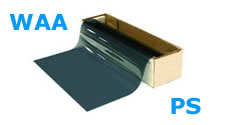
On every window film, there is a clear protective liner that you remove to expose the adhesive. Window tint adhesive usually comes in two different types: a dry and a sticky. This article will explain the difference between the two.
Dry Adhesive
Dry adhesive, or water-activated adhesive (WAA), feels like it is not actually on the film. Once you remove the protective liner, you will not necessarily feel or see anything different. They are mostly found on films made for flat-glass windows, although some do come with a sticky adhesive.
Dry adhesives are useful because once sprayed with the soap and water solution, they can be moved and positioned on the glass easily before squeegeeing into place. Any professional window film will label what type of adhesive it has.
It is recommended that you use a dry adhesive when tinting residential houses, commercial buildings, or any glass that is flat. Axis window films manufactures a full line of WAA films. You can browse films with this type of window tint adhesive here.
Sticky Adhesive
Sticky adhesive, also known as pressure-sensitive (PS) is just that: it is sticky to the touch. When you remove the protective liner from the film, you will feel a sticky layer. This type of adhesive is most common on automotive films, although some flat-glass films will come with this type.
Because of the curved glass shape, the film needs to have a stronger, tackier way of adhering to the glass to ensure that it does not bubble off. While you still use a soap and water solution when applying PS adhesive to curved glass, the film will need to heat-shrunk to fit the shape of the window. You’ll also want to give added pressure to your squeegee to make sure the film sticks down as well as possible. This is where the name “pressure-sensitive” comes from.
If you are a beginning tinter, it’s best not to use dry adhesive on flat-glass windows. Because of the large surface area of the glass, the film will stick too quickly or be hard to position.
